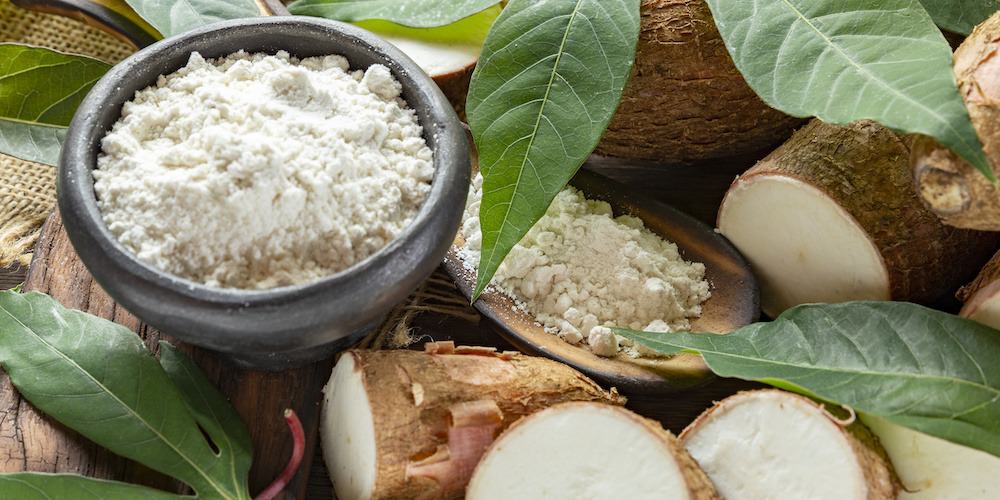BENEFITS OF CASSAVA
✓ Good source of carbohydrates
✓ Has antioxidant effects
✓ Eases skin problems
✓ Reduces bad cholesterol levels
✓ Improves digestive health and transit
What is cassava?
Cassava, scientifically known as Manihot esculenta, is a shrub native to the tropical regions of Central and South America. Like castor oil plant or rubber tree, it belongs to the large Euphorbiaceae family which includes nearly 6000 species, with about a hundred species in the genus Manihot. Although there are many cultivars and hybrids today, the typical variety is Manihot esculenta Crantz.
Sometimes considered a root vegetable, cassava is a perennial plant that can reach 5 meters in height. It is distinguished by its very long tuber which can measure up to 50 cm long and 10 cm in diameter, and weigh up to 5 kg! It has rough brown skin and whitish flesh. It produces large leaves, which are also edible, and yellow flowers in capsules.
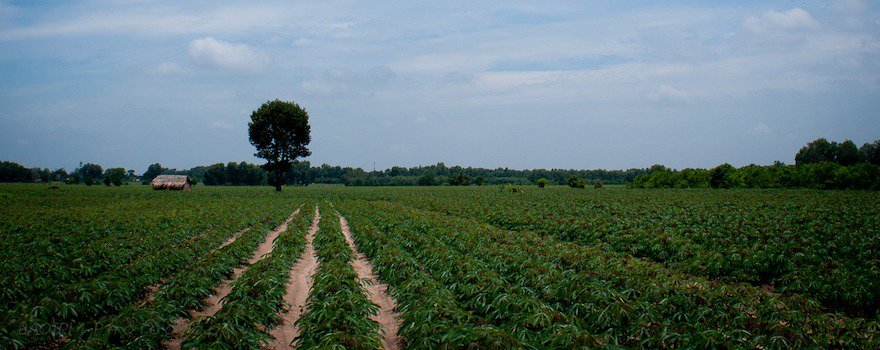
Originally, the shrub primarily grows in the Amazon regions, Guyana, and Brazil. Its tuber was consumed fried, prepared as a broth, or ground to obtain flour. It was from the 16th century that cassava was introduced to Africa where it is now widely consumed.
It is notably part of the preparation of cassava bread, attieke, a traditional dish from Ivory Coast, and “fufu”, a paste consumed as a staple food in West Africa. It is also cultivated in Asia.
In addition to their taste qualities, the cassava tuber and leaves have undeniable nutritional benefits.
The tuber is an excellent source of carbohydrates and contains many minerals and trace elements. The leaves, on the other hand, are rich in antioxidants, proteins, and vitamins.
Thanks to this composition, cassava has a satiating and antioxidant action. Its consumption is also indicated to relieve skin problems, improve transit, and reduce bad cholesterol levels.
Nutritional composition
- 9 amino acids
- Vitamins: provitamin A, B1, B2, B3, B5, B6, C, E, K
- Minerals and trace elements: magnesium, iron, calcium, potassium, sodium, phosphorus, copper, manganese, zinc
- Carotenoids: lutein, beta-carotene
- Fibers
- Proteins
- Lipids
- Carbohydrates
- Polyphenols
- Water
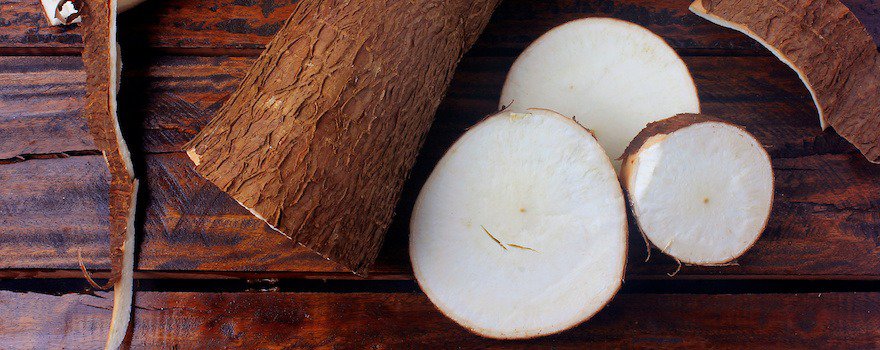
The benefits of cassava
🚴🏻♀️ Good source of carbohydrates
The cassava tuber is composed of 70% carbohydrates. So much so that approximately 500 million people now rely on it as their main source of carbohydrates.
Essential for providing energy to the body, carbohydrates are part of some proteins, ensure glycogen reserves, and improve sleep by increasing the production of tryptophan.
It mainly contains complex carbohydrates in the form of starch (amylose and amylopectin). These have a satiating role and regulate appetite. Once in the stomach, the starch swells which accelerates the feeling of fullness. Even though it is relatively high in calories (159 kcal per 100 g), it can be consumed to lose weight due to its significant satiating power and its fiber content.
This review from the University of New England (Australia) examined the nutritional composition of cassava and its good carbohydrate content for animal feed.
🥝 Has antioxidant effects
Cassava is an interesting plant for limiting damage to the body caused by free radicals. Its leaves notably contain polyphenols, vitamin C, and carotenoids (lutein and beta-carotene). These are among the nutrients and active compounds involved in combating free radicals.
In certain studies, cassava has shown itself to be interesting for protecting the liver and limiting liver lesions thanks to its antioxidant activity. Indeed, it contains two flavonols: quercetin and kaempferol. These have been shown to reduce the level of malondialdehyde, a marker of lipid oxidation by free radicals.
This study from the National Research Centre in Cairo (Egypt), conducted on rats, shows how cassava shoot aqueous extract reduces liver lesions by exerting antioxidant activity.
🍑 Soothes skin problems
For external use, cassava leaves have an antibacterial action that is particularly interesting for improving skin issues. They act notably on Staphylococcus epidermidis, a bacterium of the skin flora that can become pathogenic, and on Propionibacterium acnes, responsible for acne.
The leaves are also rich in beta-carotene, a precursor of vitamin A, which contributes to the renewal of skin cells. The tuber also contains various B-group vitamins that help maintain healthy skin.
Also read about 16 foods and dietary supplements good for the skin
This study from Padjadjaran University (Indonesia), conducted directly on clinical isolates of bacteria, demonstrates the antibacterial activity of cassava leaves.
🍳 Reduces bad cholesterol levels
Cassava seems effective at reducing the level of bad cholesterol (or “LDL cholesterol”) in the blood and increasing good cholesterol (or “HDL cholesterol”).
This action is due to its dietary fiber content and the presence of L-fucose, a monosaccharide involved in many functional roles.
It also contains interesting amino acids. Lysine, for example, contributes to the creation of carnitine which decreases cholesterol levels. Not to mention calcium and magnesium which combat excess LDL cholesterol.
This study from the Food and Nutrition Research Institute of Taguig (Philippines), conducted in humans, shows the beneficial effect of cassava on bad cholesterol levels.
♻️ Improves digestive health and transit
The starch and fibers in cassava are indicated to improve transit, prevent and relieve intestinal disorders such as constipation. The anti-inflammatory action of cassava also helps reduce colon inflammation and chronic inflammatory bowel diseases (IBDs).
Moreover, it is highly digestible and naturally gluten-free. Thus, it can be consumed in case of intolerance or celiac disease.
But more studies are still needed to assess the efficacy of cassava in improving transit.

How to consume cassava?
Fresh cassava tuber
Fresh cassava tubers can be found in specialty stores and African and Asian groceries. A quality cassava should be firm, without mold or slimy parts, and without a strong odor.
The cassava tuber can be cooked in many ways: fried, steamed, mashed, in fritters… Its taste, similar to that of potatoes, pairs very well with fish or meat. It is even possible to integrate it into desserts (cakes, pancakes…) for original and tasty recipes.
Cassava leaves
Tender cassava leaves are also interesting in cooking. They are notably used in the preparation of ravitoto, a traditional Malagasy recipe made with chopped leaves.
You can cook them like spinach, ensuring they are well-cooked. These leaves complement meat, fish, and starch dishes wonderfully.
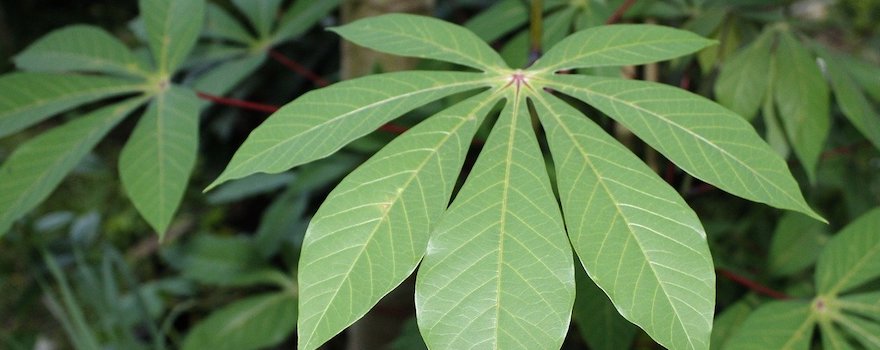
Cassava flour
After harvesting, cassava tubers are first washed and then soaked in water (retting) for several days. They are then dried and ground to obtain the precious flour.
Naturally gluten-free, cassava flour is suitable for celiac individuals and advantageously replaces wheat flour. It is ideal in baking to add softness to culinary preparations: cookies, cakes, pancakes…
In its savory form, it is enjoyed as “pão de queijo,” a Brazilian cheese bread, in vegetarian patties, or as “farofa,” a typical Brazilian side dish.
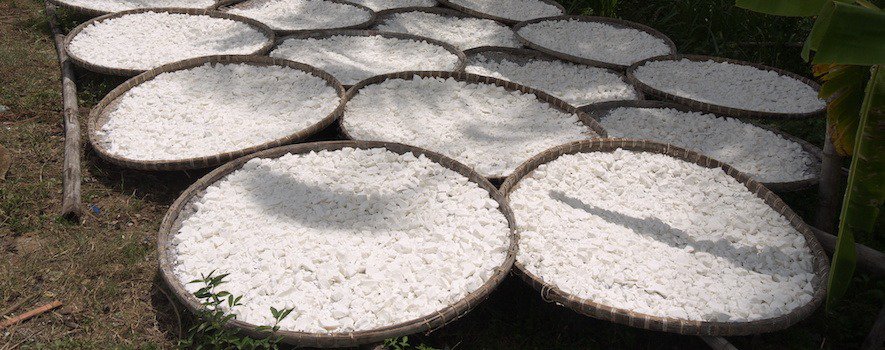
Sweet or bitter cassava?
There are two kinds of cassava: sweet cassava and bitter cassava. The former is the one we most often find on the shelves and is cooked like a vegetable.
The latter, however, is toxic when raw (as it contains hydrocyanic acid) and must therefore be processed. That’s why it is primarily used to make flour or tapioca starch.
Cassava flour or tapioca starch?
Be careful not to confuse cassava flour with tapioca starch. Indeed, the starch is derived from the starch contained in the bitter cassava tuber. The starch is then cooked and ground to make small tapioca pearls.
Tapioca starch is used for its thickening action. It adds consistency to dishes, sauces, desserts, etc.

Cassava and superfoods
To relieve digestive disorders, cassava pairs well with fiber-rich superfoods like carob and root vegetables like Jerusalem artichoke.
To maintain or lose weight, it can be combined with other natural appetite suppressants like cocoa which increases the feeling of fullness.
Consume sustainably: favor organic and fair-trade cassava
✓ Today, 70% of the world’s cassava is produced in Nigeria, Brazil, Indonesia, the Democratic Republic of Congo, and Thailand. It is mainly cultivated by small-scale farmers with low incomes. Cassava constitutes an important financial resource and food security for them. That is why we recommend choosing a fair-trade product that ensures fair prices and values the work of these producers.
✓ In France, it is cultivated in certain departments and overseas regions like Réunion Island or the Antilles. However, the production is rarely exported to the mainland.
✓ Finally, prioritize cassava from organic farming, grown without chemical fertilizers, pesticides, and insecticides.
Dosage
There is no specific recommended dosage regarding cassava consumption. Just be sure to not overdo it as it is quite caloric compared to other root vegetables.
🥔 Fresh tuber: 250 g per person per day.
🌱 Leaves: 500 g for 1 to 2 liters of water.
🥄 As flour: substitute the same quantity of cassava flour for wheat flour.
Contraindications and side effects
Consuming cassava has certain contraindications. It is particularly advised against for people suffering from iodine deficiency or thyroid problems.
Additionally, the tuber contains cyanogenic glycosides (linamarin and lotaustralin) which can transform into hydrocyanic acid and cause poisoning with the following side effects:
- Headache
- Stomach ache
- Vomiting
- Diarrhea
If you experience side effects, stop consumption and consult a doctor.
History, culture, and market of cassava
With 250 million tons produced each year, cassava is the 5th most cultivated food plant worldwide, following maize, rice, wheat, and potatoes. Africa accounts for 47% of global production. It has become the main food source on the continent and a staple food for a large number of populations.
But climate change heavily weighs on this crop. It promotes pest insect populations and the development of viral diseases (African mosaic and cassava brown streak) which cause significant damage in the fields. An international partnership has even been established to address the threat of cassava diseases in Africa (Global Cassava Partnership for the 21st Century).
Report prepared by Julia Perez and Charlotte Jean
Sources and scientific studies
Younoussa Diallo, Momar Talla Gueye, Mama Sakho, Praxède Gbaguidi Darboux, Amadou Kane, Jean-Paul Barthelemy & Georges Lognay, 2012. Nutritional importance of cassava and prospects for it as a staple food in Senegal (literature review).
Julie A. Montagnac, Christopher R. Davis, Sherry A. Tanumihardjo, 2009. Nutritional Value of Cassava for Use as a Staple Food and Recent Advances for Improvement.
Natalie K. Morgan and Mingan Choct, 2016. Cassava: Nutrient composition and nutritive value in poultry diets.
Abdelsamed Elshamy, Abd El-Nasser G El Gendy, Abdel Razik H Farrag, Jihan Hussein, Nadia A Mohamed, Walaa A El-Kashak, Simona Nardoni, Francesca Mancianti, Marinella De Leo, Luisa Pistelli, 2020. Shoot Aqueous Extract of Manihot esculenta Crantz (Cassava) Acts as a Protective Agent Against Paracetamol-Induced Liver Injury.
Resmi Mustarichie, Sulistiyaningsih Sulistyaningsih, Dudi Runadi, 2020. Antibacterial Activity Test of Extracts and Fractions of Cassava Leaves (Manihot esculenta Crantz) Against Clinical Isolates of Staphylococcus epidermidis and Propionibacterium acnes Causing Acne.
Trinidad P. Trinidad, Rosario S. Sagum, Aida C. Mallillin, Melissa S. Borlagdan, Marco P. de Leon, Theressa F. Aviles, 2013. Sweet Potato and Cassava Can Modify Cholesterol Profile in Humans with Moderately Raised Serum Cholesterol Levels.


